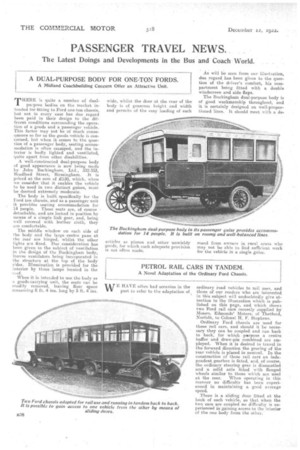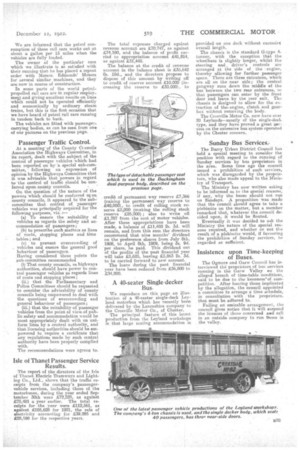PASSENGER TRAVEL NEWS.
Page 22

Page 23

If you've noticed an error in this article please click here to report it so we can fix it.
The Latest Doings and Developments in the Bus and Coach World.
A DUAL-PURPOSE BODY FOR ONE-TON FORDS.
A Midland Coachbuilding Concern Offer an Attractive Unit.
THERE is quite a number of dualpurpose bodies on the market intended for fitting to Ford one-ton chassis, hut not in every case has due regard been paid in their design to the different conditions surrounding the operation of a goods and a passenger vehicle. This factor may not be of much consequence so far as the goods vehicle is concerned, but when it comes to the question of a passenger body, seating accommodation is often cramped, and the interior is badly lighted and ventilated, quite apart from other disabilities.
A well-constructed dual-purpose body of good appearance is now being made by John Buckingham, Ltd., 332-333, Bradford Street, Birmingham. -It is priced atthe sum of £150, which, when we consider that it enables the vehicle to be used in two distinct guises, must be deemed extremely moderate.
The body is built specifically for the Ford ton chassis, and as a passenger unit it provides seating accommodation for 14 people. These seats are, of course • detachable, and are locked in position by means of a simple link gear, and, being well covered with leather cloth, they are comfortable.
The middle window on each side of the body and the large centre pane at the rear are hinged, whilst the other lights are fixed. Due consideration has been given to the subject of ventilation in the design of the Buckingham body, louvre ventilators being incorporated in the structure at the top of the body sides. Illumination is provided for the interior by three lamps located in the toot
When it is intended to use the body as a goods-carrying unit, the seats can be readily removed, leaving floor space measuring 8 ft. 4 ins, long by 5 ft. 4 ins.
wide, whilst the door at the rear of the body is of generous height and width and permits of the easy loading of such articles as pianos and other unwieldy goods, for which such adequate provision is not often made.
As will be seen from our illustration, due regard. hasbeen given to the question of the driver's comfort, his compartment being fitted with a double windscreen and side flaps.
The Buckingham dual-purpose body is of good workmanship throughout, and it is certainly designed on well-proportioned lines. it should meet with a de mand from owners in rural areas who may not be able to find sufficient work for the vehicle in a single guise.
PETROL RAIL CARS IN TANDEM.
A Novel Adaptation of the Ordinary Ford Chassis.
WE HAVE often had occasion in the past to refer to the adaptation of ordinary road vehicles to rail uses, and those of our readers who are interested in this subject will undoubtedly give attention to the illustration which is published on this page, and which shows two Ford rail cars recently supplied by Messrs. Edmonds' Motors, of Thetford, Norfolk, to Colonel H. F. Stephens.
Ordinary Ford chassis are used for these rail cars, and should it be necessary they can be coupled and run back to back, for which parpose a centre buffer and draw-pin combined a-re employed. When it is desired to travel in the forward direction the gearing of the rear vehicle is placed in neutral, In the construction of these rail cars an independent gearbox is fitted, and, of course, the ordinary steering gear is 'dismantled and a solid axle fitted with flanged wheels similar to those which are used at the rear. When operating in this manner no difficulty has been experienced in maintaining a good average speed.
There is a sliding door fitted at the back of each vehicle, .so that When the two cars are coupled no difficulty is experienced in gaining access to the interior of the one body from the other.
We are informed that the petrol consumption of these rail cars works out at about a gallon per 15 miles when the vehicles are fully loaded.
The owner of the particular cars which we illustrate is so satisfied with their running that he has placed a repeat order with Messrs. Edmunds' Motors for several similar machines, and they are now in course of construction.
In some parts of the world petrolpropelled rail cars are in regular employment and giving excellent results on lines which could not be operated efficiently and economically by ordinary steam trains, but this is the first occasion that we have heard of petrol rail cars running in tandem back to back.
The vehicles. are fitted with passenger. carrying bodies, as can be seen from one of our pictures on the previous page.
Passenger Traffic Control.
At a meeting of the County CtunciIs Association the Highways Committee, in its report, dealt with the subject of the control of passenger vehicles -which had been reported on bya Special sub-committee, following an expression of opinion by the Highways Committee that it was advisable that powers in regard to the control of traffic should he conferred upon county councils.
On the, question of the nature of the powers which should be conferred Ilion county councils, it appeared to the 'subcommittee that control of passenger vehicles was principally required for the followine•° purposes, viz,
(a) To ensure the suitability of vehicles as regards the safety and accommodation of passengers; (b) to prescribe such matters as lines of route, stopping places and time tables ; and (c) to prevent overcrowding of .. vehicles and ensure the general good behaviour of passengers. Having considered these points the sub-committee recommended (i) That county councils, as highways authorities, should have power to control passenger vehicles as regards lines of route and stopping places; (ii.) that the Parliamentary and Police Committees should be requested to consider the advisability of county councils being empowered to deal with the questions of overcrowding and general behaviour of passengers; (iii.) that. the suitability of passenger vehicles from the point of view, of public safety and accommodation would be most appropriately dealt with on uniform lines by a central authority, and that licensing authorities should be empowered to require a certificate that any regulations made by such central authority have been properly complied with.
The recommendations were agreed, to.
Isle of Thanet Passenger Service Results.
The report of the directors of the Isle of Thanet Electric Tramways and Lighting Co., Ltd.. shows that the traffic receipts from the company's passengervehicle services, including those of the motorbuses, during the year ended September 30tl were £72,525, as against £75,481 a year earlier. The total receipts for the year were £112,561, as against £105,628 for 1921, the sale of electricity accounting for £39,285 and £28,598 for the respective years. The total expenses charged against revenue account are £70,747, as against £74,180, and the balance of profit carried to appropriation account £41,814, as against £31,448.
The balance at the credit of revenue account in the balance sheet is £35,642 Os. ,10d., and the directors propose to dispose of this amount by writing off to credit of reserve account £10,000 (increasing the reserve to £30,000), to
credit of permanent way reserve £7,366 (raising the permanent way reserve to £40,000), to credit of rolling stack reserve £5,000 (making the rolling stock reserve £25.000); also to write off £1,787 from the cost of motor vehicles. After these appropriations have been made, a balance of £11,488 2s, 3d. will remain, and from this sum the directors recommend that nine months' dividend on the preference shares from July 8th, 1908, to April 8th, 1909, being Ss. 9o1. per share, be paid. This dividend out of the profits of the past financial year will take £5,625, leaving £5,863 2s. 3d. to be carried forward to new account.
The loans during the past financial year have been reduced from £36,800 to £34,800.
A 40-seater Single-decker Bus.
We reproduce on this page an illustration of a 40-seater single-deck Leyland motorbus which has recently been delivered by the Lancashire company to the Crosville Motor Co., of Chester.
The principal feature of this latest production from tire Leyland workshops is that large seating accommodation is provided en one deck without excessivi overall length.
The chassis is the standard G-type 4tanner, with the exception that the wheelbase is slightly longer, whilst the steering and driver's controls are arranged at the side of the engine, thereby allowing for further passenger space. There are three entrances, which are all on the near side; the central gangway runs down the middle ef the bus between the two rear entrances, so that passengers can enter by the front door and leave by the rear exit. The chassis is designed to allow for the •ex. traction of the engine, clutch and gearbox without removing the body.
The Crosville Motor Co. now have over 20LeyIands—mostly of the single-deck type, and they have proved a great aaccess on the extensive bus system operated by the Chester concern.
Sunday Bus Services..
The Barry Urban District Council has held a special meeting to consider the ositicin with regard to the running of Sunday services by bus proprietors in the area. Some time ago the council issued a prohibition of such services, which was disregarded by the proprietors, who also made appeal to the Ministry of Transport.
The Ministry has now written asking to be informed as to the special reasons, if any, why the buses should not run on Sundays. A proposition was made that the council should agree to take a plebiscite on the matter, but a member remarked that, Whatever the.council decided upon, it would be flouted.
Eventually it was decided to ask the Ministry • the nature of the special reasons required, and whether or not the result of a plebiscite would, if favouring the prohibition of Sunday services, be regarded as sufficient.
Insistence upon Time-keeping of Buses.
The Ogmore and Gam Council has interviewed the proprietors of bus services running in the Clarw Valley en the alleged breach of time-table conditions, said to be due to the keenness'of competition. After hearing those implicated by the allegation, the council appointed a committee to arrange a time schedule, in consultation with the proprietors. that, must be adhered to.
Failing an amicable arrangement, the council gives notice that it will suspend the licences of those concerned and call in an outside company to run Usises in the valley.






























